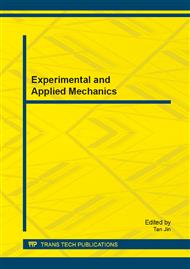p.170
p.178
p.184
p.190
p.196
p.201
p.209
p.215
p.220
Studying the Effects of Different Materials and Thickness of Titanium Layer to Implant Based on the Finite Element Method
Abstract:
Implant young's modulus has a decisive role on bone interface stress distribution and transmission. In this paper, using UG software, change the traditional titanium implants into a new implant by the different thickness of the titanium layer wrapped in a variety of materials, and using ansys workbench changes thickness and Young's modulus of the core material, analysis of various the case of force and deformation of the implant, looking for a good biomechanics is both compatible with good mechanical properties and implant materials. Through analysis, the ratio of all the results obtained: titanium layer thickness and Young's modulus of the core material has an impact on force and deformation.
Info:
Periodical:
Pages:
196-200
Citation:
Online since:
February 2014
Authors:
Keywords:
Price:
Сopyright:
© 2014 Trans Tech Publications Ltd. All Rights Reserved
Share:
Citation:


